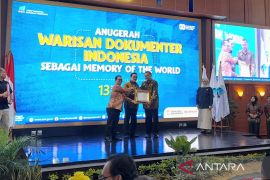Boarding MV Orion, on an expedition cruise ship from the Australian Northern Territorial city of Darwin, the tourists have an opportunity to arrive at Nama port on the west coast of that small, rocky island.
In its spice island adventure voyage of discovery from Darwin, the Orion cruise ship was again on Wednesday fortunate to have the luxury of coming alongside the wharf of Nama port.
From there the tourists got off the ship and made their way to convoy of local cars which took them to the district town of Wonreli for an official welcome speech by a district administration official.
After that, the tourists headed to Kukmoumour tourism attraction at the foot of Mauhara hill in Oirata village on the southern part of the island.
"While in Kukmoumour, the tourists seem to love every minute of it because they can find so much to enjoy: the feel of gentle breeze, the awesome grandeur of the strait separating Kisar from Timor Leste, and the sound of waves splashing on the fair shore of Kiasar beach," Oirata Village head John Ratuluhain told Antara by his cell phone.
Ratuluhain said that from the hill of Kukmoumour, the tourists then descended to Kiasar beach where they were entertained with colorful local traditional Pe`uk and Cakalele dances.
Kiasar beach has a narrow coastline but it is suitable for marine tourism.
The beach has a lot to save the history of Kisar island. It was the beach where the the Dutch first landed on Yotowawa island and then called it Kisar after the name of Kiasar beach.
"The tourists also have the opportunity to see a number of activities including "sopi" alcoholic drink distilling, palm sugar making, and ikat weaving for sale," Ratuluhain said.
He explained that Wednesday`s arrival of MV Orion with hundreds of tourists from many countries in Kisar to visit Kiasar beach in Oirata village was not the first of its kind.
The cruise ship since 2008 has been making Kisar part of its regular ports of call twice a year in its spice island adventure voyage of discovery.
"MV Orion has for many years carried hundreds of tourists from many countries to Kisar because the island has a lot to offer," Southwest Maluku Culture and Tourism Office spokesman Anes Dahoklory says by his cell phone from Wonreli, the district capital.
Dahoklory said Kisar has many white sandy beaches with crystal clear water where the tourists could stroll along, or go swimming, snorkeling and diving.
"They can also visit the ruins of Forth Vollenhove at Nama beach, Forth Delfthaven in Kaisama village, the ruins of Leklor old church, or climb up to the top of Daitilu, the tallest mountain in Kisar to see the natural beauty around the island," he went on.
The Leklor old church was built by Dutch in 1777 and caught fire in 1925 but the ruins are still there for everyone to see.
Kisar is one of many islands in Southwest Maluku district and, in short, there is nothing here.
"But of course, by nothing it means nothing as in the terms of not much development, but a lot of nature," local culture and tourism office spokesman Anes Dahoklory says.
No matter how remote this island is, Dahoklory noted that it was still developing its tourism sites.
Meanwhile, Oirata village community figure Lucas Wedilen said that as part of Maluku`s southwestern islands, Kisar was in the past one of the remotest and least accessible in all Indonesia.
But now both sea and air transportation to Kisar is no long a big problem.
"Even now some hotels and restaurants are already available for visitors, especially the tourists who can have some fine beaches and snorkeling spots to enjoy," Wedilen said.
Geographically, Kisar is closer to Australian continent and culturally nearer to Timor Leste and has a real Timorese feel to it, with villages scattered in the dry, scrubby interior rather than along the coast.
Sights are limited to a very few colonial buildings such as a ruined old church at Leklor village, Fort Vollenhove at Nama beach, and Fort Delftshaven at Kaisama village which are the most impressive for foreign visitors.
Some of the finest "Ikat Weavings" are found in Kisar, and the best of these are made by the people of Oirata village with some of unique traditional-style houses left.
Previously known as "the Moluccas", the Maluku region is truly a collection of forgotten islands located just north of Australia.
Sitting between New Guinea and Timor Leste, it is part of Wallacea, the legendary deep water area that separates the Australian and Asian continent plates.
The southwest corner of Maluku is virtually inaccessible but is home to numerous stunning islands with fringing reefs and ancient culture.
Very few outsiders have ever set foot on these islands and a unique experience is guaranteed as the MV Orion`s crew members and guests discover the "Forgotten Islands" of Maluku.
Their visit on November 7, 2012 to the tiny island of Kisar served as their official entry point into the archipelago.
Kisar has over 400 years of European history and despite being only a few hundred miles off the coast of Australia, its European history is virtually unknown. (*)
Reporter: Otniel Tamindael
Editor: Otniel Tamindael
Copyright © ANTARA 2012











